Originally published 1 August 1983.
For almost 20 years I have ranged the woods and fields near my home in eastern Massachusetts. Most of the plants and animals have become familiar friends. By paying close attention to the weather, I can predict almost to a day when the first red-wing blackbird will reappear along the brook, or when the first cinnamon fern will unfurl its fiddleheads near the pond. There is a pleasure in the familiar, in the recurring patterns of the seasons.
But there is also a special pleasure in the unexpected. Consider the wild columbine. Not a particularly rare wildflower, I am told. But around here it is rare enough that in all my years of walking, I have seen only one plant. I found it growing on a rocky outcrop in the deep woods. It came, apparently, from nowhere, and left without progeny. A miracle, it seems, of creation from nothing.
No, not a miracle. Somehow a columbine seed had made its way to my rocky outcrop. That tiny package contained the blueprint for the finished plant. The orange, five-part nodding blossoms. The trailing spurs. The golden stamens, showering like fireworks from the bells. They were all there, marvelously encapsulated in a tiny seed that somehow made its way to my outcrop like a cosmic space traveler.
The origin of my columbine was a mystery which is enfolded within the greater mystery which is the origin of life itself. That greater mystery has been poked and prodded by science, it has yielded secret after secret, and yet the mystery remains as deep as ever.
I can be certain that my wild columbine grew from a seed, and that the origin of the seed was another columbine plant in someone else’s woods. But how did the first living thing come to be, the creature without a parent?
The first living creatures
The first living creatures were single-celled organisms, perhaps similar to the simplest bacteria existing today. Those primitive cells had the ability to survive over the short run by extracting energy from their environment, and to survive the long run by reproduction of their species. They were the first tentative steps on life’s precarious journey.
The bacterium and the blue whale, the elephant and the columbine, all share the same chemistry under the skin. The molecular building blocks of life are surprisingly limited — carbohydrates, fats, proteins and nucleic acids — the sorts of things you find listed on the side of your breakfast food box. The original building blocks for life were fabricated from materials available in the early oceans and atmosphere.
A series of experiments in the 1950s, and repeated and refined since, hints at how life happened. Researchers introduced ammonia and methane with water into a flask and subjected the mixture to a continuous electrical discharge. When the spark was turned off, the walls of the flask were coated with a scum of organic compounds. In particular, the amino acids, which are the subunits of the proteins, were found in the flask.
The experiments were an attempt to recreate the conditions that existed on the early earth. The same chemical reactions that occurred in their flask can be presumed to have happened in the early environment.
Building organic molecules out of simple gases and water requires energy. In the experiments, the energy source was an electric spark. On the early earth the main sources of energy were ultraviolet light from the sun and the crackle of lightning in the atmosphere.
As time passed, organic molecules began to accumulate in ancient seas. The waters of the earth became a chemical storehouse, a rich broth of organic ingredients. The stage was set for another level of synthesis.
Next, the threads of life
The next step was a big one: the creation of the very large molecules, the proteins and nucleic acids which are the threads of life. Proteins are chains of hundreds of amino acids, linked together in a particular sequence. The nucleic acids are even more complex than the proteins. The nucleic acid DNA, which contains the genetic code of living organisms, is a chain of sugars, phosphates, and organic bases which can have more than a billion links.
Water was necessary to collect and concentrate the molecular subunits of the proteins and nucleic acids. Creating the chemical links that held the subunits together in a chain required dehydration. How these apparently contradictory conditions were realized simultaneously is something of a mystery.
It is a further big step between the appearance of the first proteins and nucleic acids and the first living cells. It is like the step between a stack of pipes and valves and an operating petroleum refinery. At this point, scientists can do little more than guess at how the step was taken.
The assembly of proteins, nucleic acids, and finally living cells spontaneously from nonliving matter involved a sensitive balance of raw materials, energy, environment and time. Scientists may never see life leap spontaneously from a laboratory flask. Even if they could somehow recreate the physical conditions that prevailed on the earth 3.8 billion years ago, the one ingredient they cannot reproduce is time.
The unanticipated wild columbine on the woody outcrop seemed a bit of a miracle. The origin of life on earth seems still more miraculous. Research in molecular biology has taken us a long way toward understanding how the “miracle” happened. The mystery may yet yield to experiment and reason. “Nothing,” said the 19th century physicist Michael Faraday, “is too wonderful to be true.”



